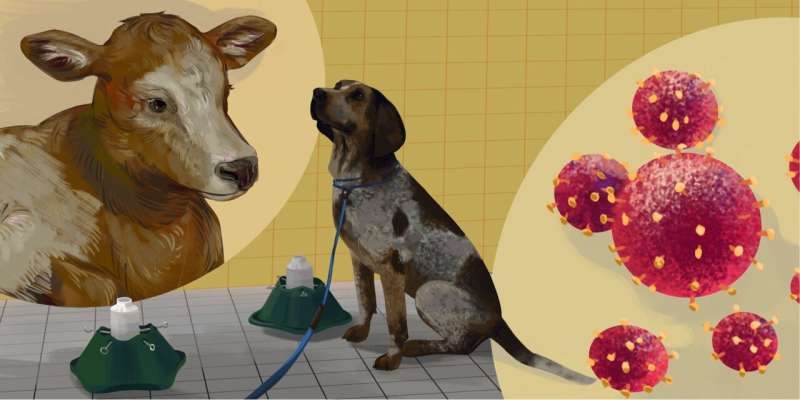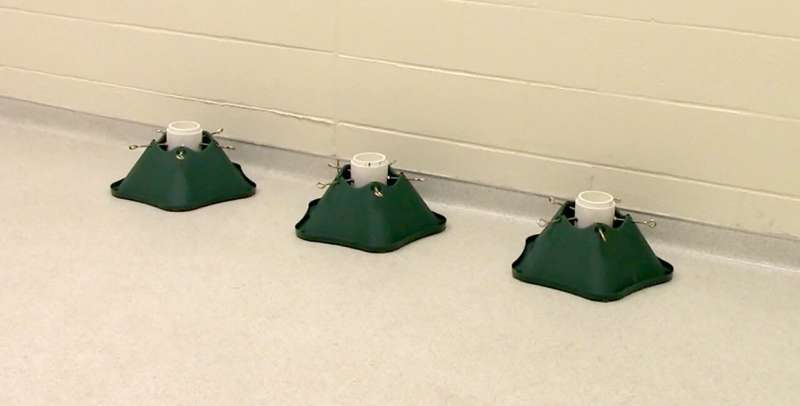
A Texas A&M AgriLife researcher is getting a site out of human illness investigation to see if dogs may be equipped to sniff out bovine respiratory disease, BRD, a person of the premier health and fitness difficulties for the feedlot cattle marketplace.
Courtney Daigle, Ph.D., an animal welfare professional in the Texas A&M Office of Animal Science in the Texas A&M School of Agriculture and Everyday living Sciences, and her doctoral scholar, Aiden Juge, are commencing the second spherical of schooling to decide if canines can routinely and properly detect BRD in cattle.
She will work with BRD expert John Richeson, Ph.D., from West Texas A&M College in Canyon, and pet dog education skilled Nathan Hall, Ph.D., from Texas Tech College. Hall specializes in canine olfaction, normally identified as a dog’s perception of scent, and Richeson provided the 1st established of nasal swabs from cattle employed in the pilot research.
The benefits of the team’s initially study ended up not long ago released in two significant journals: “Canine olfaction as a condition detection technological know-how: A systematic overview” in Utilized Animal Behaviour Science, and “Making use of Canine Olfaction to Detect Bovine Respiratory Illness: A Pilot Review” in Frontiers in Veterinary Science.
Canine olfactory capacity has been productively made use of to detect and diagnose human conditions, and this team is on the lookout to develop that achievement. For BRD, Daigle mentioned their pilot screening aided illuminate what education, products and other parameters are required to increase the level of correct predictability.
Now the staff is starting their 2nd examine, making use of cattle at the Texas A&M McGregor Exploration Heart in Central Texas and guard puppies from the jail in Huntsville.

Bovine respiratory disorder consequences on the business
Daigle mentioned this technological innovation could revolutionize how antimicrobial treatment method is utilized in business beef creation. At the moment, cattle well being is evaluated at the team degree, ensuing in mass administration of antimicrobials to an whole group, irrespective of individual animal wellness position.
- BRD is a main worldwide induce of cattle morbidity and mortality thanks to the deficiency of trustworthy screening and restricted vaccine efficacy.
- Cattle with BRD are demanding to recognize and diagnose.
- The prevalence of BRD in U.S. feedlot cattle has been documented at 16.2{530e870c018efe4faeaf1650f5521f73bbd950ecc9f753be09e2bfdaa8245e82}.
“We suggest that appropriately qualified puppies will correctly and quickly forecast BRD hazard in unique cattle, and converse that data to people in real time, ensuing in a focused technique to managing BRD working with antimicrobials,” she said.
This research could catalyze a paradigm shift in how feed yards use antimicrobials. Producers will make the most of the dogs’ excellent olfactory process for chute-facet sickness detection.
“A well-properly trained canine and handler positioned in close proximity to the chute generates a situation the place the puppy can quickly and calmly evaluate restrained cattle and sign a diagnostic selection to the handler,” Daigle reported. “Metaphylactic software would then transition from team software to implementation on an particular person animal foundation.”
Dealing with only the animals that the puppies indicate actually require intervention would lower drug price and use in contrast to the latest approaches. Furthermore, this will reveal that the livestock marketplace is demonstrating improved antimicrobial stewardship and advertising cattle welfare, even though giving the global populace with superior-high quality protein.

The pilot study
Being aware of that canines can detect people and animals affected by a selection of health conditions based mostly on scent, Daigle’s staff set out to figure out if the canines’ olfactory methods can distinguish between styles of volatile natural and organic compounds made by healthier tissue compared to tissue infected with BRD.
In the pilot study, two dogs have been skilled in a sequence of stages about 7 months to discriminate amongst nasal swabs collected upon arrival at the feedlot from cattle that made indicators of BRD within just 20 times and swabs from cattle that did not produce BRD indicators within 3 months at the feedlot.
The two canine have been picked from the Office of Veterinary Pathobiology in the Texas A&M College of Veterinary Medicine and Biomedical Sciences. Nasal swabs have been gathered from 395 crossbred beef cattle at the West Texas A&M College Investigation Feedlot in Canyon involving December 2020 and March 2021.
Following sample assortment, the cattle ended up monitored for three months. Samples ended up categorised as good if the supply animal was treated for BRD at the very least 3 moments or died right after at least a single treatment for BRD within just 20 times of arrival.
Success and refinement
Daigle claimed in the pilot examine, the outcomes ended up just marginally above probability for the canine sniffing out nasal swabs from favourable-tests cattle.
Due to the fact of the complexity of BRD pathogenesis, if detection is reliant on a pathogen-specific odor, BRD may perhaps be extra challenging than other ailments for canine to detect, the crew concluded. In the pilot examine, they established that varying field disorders, seasons and sexual intercourse scent distinctions may have influenced the in general end result, hence restricting the precision with which BRD could be diagnosed.
Due to the fact of these uncertainties, conducting even further exploration with amplified handle of sample high quality, additional exact timing of sample selection relative to sickness, and greater sample uniformity is essential, Daigle claimed.
In this next spherical, two new puppies will be picked, and samples have been taken from cattle that are homogenous in breed, sexual intercourse and origin. The team gathered equally nasal and saliva samples to appraise the impact of the sample form on detection precision.
“If these puppies can discriminate between samples from ill and nutritious cattle underneath hugely controlled ailments, then producers could have yet another instrument in their cattle-management toolbox when it arrives to detecting BRD,” Daigle explained. “Also, these final results might catalyze further research that could look at what compounds are responsible for individuals scent variations, foremost to the development of sensors for BRD.”
More data:
Aiden E. Juge et al, Canine olfaction as a disease detection technological innovation: A systematic overview, Used Animal Behaviour Science (2022). DOI: 10.1016/j.applanim.2022.105664
Aiden E. Juge et al, Employing Canine Olfaction to Detect Bovine Respiratory Illness: A Pilot Review, Frontiers in Veterinary Science (2022). DOI: 10.3389/fvets.2022.902151
Quotation:
Can pet dogs sniff out bovine respiratory condition? (2022, December 23)
retrieved 23 December 2022
from https://phys.org/information/2022-12-dogs-bovine-respiratory-illness.html
This document is matter to copyright. Aside from any good dealing for the goal of personal examine or investigation, no
part may be reproduced devoid of the composed authorization. The material is provided for information functions only.


More Stories
Keeping Your Dog Safe and Comfortable During Car Rides
Bluetick Coonhound Dog Breed
Celebrity Shiba Inu Names: Inspired by the Stars